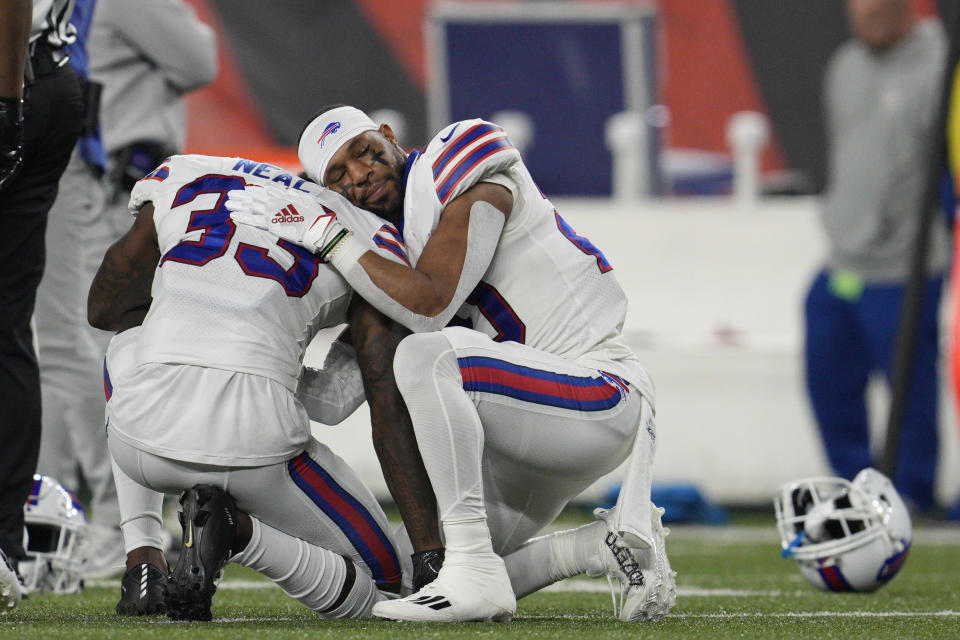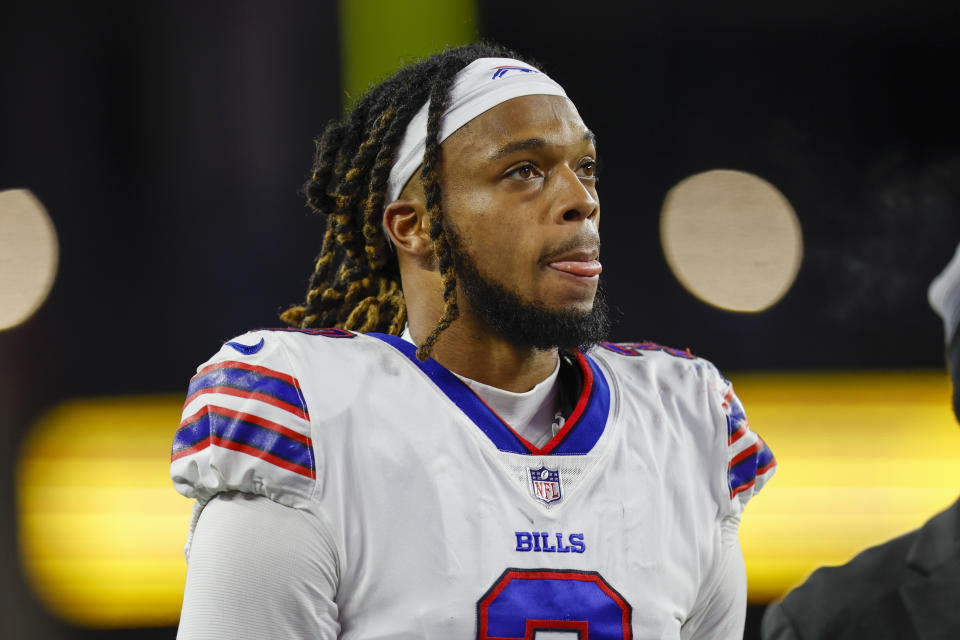Someone made the right call. The human call. The only call, really.
When it mattered, when only the compassionate decision made sense, the show did not go on.
Instead, Monday Night Football ended in a maelstrom of agony, frustration and 1,000-yard stares. We watched as two teams locked arms in a cocoon of humanity around Buffalo Bills safety Damar Hamlin, who was receiving CPR compressions after colliding with Cincinnati Bengals wideout Tee Higgins and then falling unconscious in front of a national television audience. Nearby, players and staffers cried and held each other. Others pulled at their jerseys and clothing, or simply put their face into their hands and melted.
In a league that has come to stretch the boundaries of what we accept as normal and part of the gladiator sport, this moment was something different than anything we’ve seen in the social media age of the NFL. The veneer of an impenetrable facade fell way, exposing limitless vulnerability and a reality that has stalked this league forever: There is a line. A brutal, awful line. And the discovery of it was every bit as horrific as we presumed it would be.
As witnesses, that’s what Monday night represented to us. Something different. A significant inflection point for the NFL, when all the talk about players putting their lives on the line suddenly coalesced into a collective image that won’t soon be forgotten. One that underscored what we’ve learned in so many ways over so many decades: That inside this vicious form of entertainment, every hit carries an inherent danger of changing someone’s life forever. Or ending it altogether.
We absorbed that Monday night. The brutal, awful line that finally became so clear that someone involved — maybe nearly everyone involved — understood that no game should be unstoppable. Not for our entertainment. Not for ratings and commercial sponsors. Not for the trivialities of sports betting and fantasy football. Not even for the long-embraced tradeoff that we’ve been sold for so long, that risking life and limb is simply an extension of a football contract.


We’ve always known there is such a thing as too far, even in the NFL. What we didn’t know is what it would look like or how it would make us feel. When we wake up Tuesday, we won’t be able to say that anymore. Instead, players will know that it feels like losing a sense of invincibility, resilience and control. Fans will know it feels like staring at an image and begging for a player to simply move, anything that returns the moment back to the warped relief of the phrase “he has feeling in his extremities.”
Perhaps most important, the NFL will know what it’s like to have every part of the machine simply refuse to respond in the face of a nightmare. The league got a good look at players who were never going to play again that night. Coaches who were never going to coach. Fans and journalists who — for the most part — refused to engage in absurd rationalizations about what a cancellation could mean for logistics or playoff implications.
For once, maybe the first time since the NFL shut down briefly in the wake of the 9/11 terrorist attacks, something else had to be more important than the product. That something was the safety of Damar Hamlin and the well-being of everyone around him. If that wasn’t more important than finishing a prime-time football game, it would validate the criticism of everyone who framed the league as a soulless money machine.
This is why we scoffed when the ESPN broadcast suggested play would go on after a 5-minute warmup. Nothing about that made sense. The grief and backlash after hearing it — everything about that made sense. The NFL has denied knowing where that suggestion came from, but it certainly didn’t end up on the broadcast from nowhere. For a league reputation dogged by skeptics and conspiracy theorists, the moment will never truly be settled.
In the end, what matters most is that the machine stopped. The line was recognized by someone, somewhere. And when that happened, it allowed us to turn all of our attention to Hamlin, which is where it belonged from the moment he collapsed on the field from cardiac arrest.


As former Pittsburgh Steelers safety Ryan Clark framed it on ESPN on Monday night, “For over 100 grown adult men, who their entire lives have put on pads and understood the risk you take every time you do it, to be speechless, to be in tears, to be gathered in prayer, that tells you how significant this moment was. …
“In truth, if the NFL cares about the players, this is the first time I believe the NFL truly had to care about the players’ emotional and mental health as well. This is the first time we got to watch those emotions, we got to watch that type of thought process right in front of us.”
The unfolding of this lesson has long seemed inevitable. And as we imagined, the cost to learn it was as awful as it was predictable. Damar Hamlin is fighting for his life in the hospital and the moment that may have changed his life now resides in our memory forever.
This was the most terrible way to learn where the NFL’s line between entertainment and humanity gets drawn. Not to mention how much is actually being risked on either side of it.
